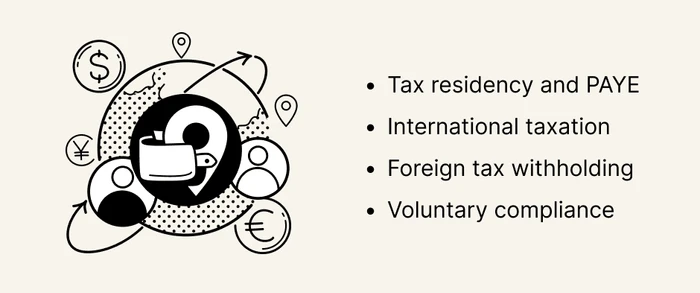How to Pay International Employees: A Deep Dive Into All Key Considerations
As businesses expand their teams globally, the challenge of paying international employees looms large. It's a complex undertaking, far removed from the simplicity of writing a cheque or making a simple bank transfer. The platforms businesses traditionally used may not seamlessly accommodate employees in various locations, and the intricacies of international tax regulations and labour laws only add to the issue. But if you end up choosing the right payroll method, the rewards of global expansion will be substantial.
In this article, we'll navigate the world of international payroll and explain how to complete this process with ease while staying within the law. Let's dive in!
Understanding the Complexity of International Payroll
When it comes to hiring international employees and paying them remotely, you may come across several unique scenarios. You might be a company compensating foreign workers temporarily, sending an employee overseas for a project, or assembling a remote team across the globe to support your expansion into foreign markets. In any of these cases, relying solely on your usual local payroll system won't cut it.
But before you explore alternative payroll solutions, there are essential factors to consider. These considerations are crucial to setting up an international employee arrangement that aligns with your specific needs.
Different Currencies
A fundamental aspect of international payroll is dealing with various currencies. Employees overseas typically expect to be paid in their local currency. This requires you to have effective processes for currency conversion, understanding exchange rates (more about them later in the article), and managing potential fluctuations. How you handle these currency dynamics will significantly affect the final amount your employees receive, as well as the trust and satisfaction between your organisation and its global workforce.
Different Labour Laws
Employment regulations can be vastly different from one country to another, creating a complex legal landscape. Ensuring compliance with local labour laws may seem like a formality, but in reality, from a company's perspective, it's a shield against potential legal issues, financial penalties, and disputes.
So, you need a thorough understanding of requirements such as minimum wage, working hours, overtime regulations, and a multitude of other labour-related nuances. You don't know which local and international laws apply until you check.
The Key to Compliance: Taxes

Let's say you're a UK business navigating payroll taxes. Your main considerations are:
- Tax residency and PAYE. If your international employee isn't a UK resident and doesn't work in the UK, you usually won't deduct UK income tax (PAYE). For instance, if you hire someone from Spain to work remotely for your company, you generally won't deduct UK income tax from their pay.
- International taxation. When your employee works exclusively outside the UK, they'll likely pay taxes in their country of residence. For example, if you hire someone in Canada to represent your UK company there, they'll pay Canadian taxes.
- Foreign tax withholding. Sometimes, you may need to withhold foreign tax from your employee's salary and send it to their home country's tax authority. For instance, if you hire someone in the United States, you might need to withhold US taxes on their earnings.
- Voluntary compliance. Even if it's not required, registering for payroll taxes in your employee's home country can simplify tax matters. If you have an employee in Italy receiving gross pay from your UK payroll, they might choose to settle their Italian taxes by filing a tax return in Italy.
National Insurance / Social Security Contributions
Unlike income tax, where you can sometimes split earnings based on where work is done, social security contributions are usually tied to the employee's location. They're either under the local system or the social security system of the country where the employee works — no in-between.
More About the Legal Landscape: Contracts and Legal Requirements
In addition to what has been said already, let's touch upon contracts and agreements. These legal elements form the backbone of a structured and compliant approach to managing your global workforce.
Employment Contracts
You need to determine whether workers fall into the category of independent contractors or full-time employees. This involves various factors: work hours, length of tenure, nature of work, project duration, benefits, and tax obligations, among others. It's also crucial to note that while working with overseas contractors may seem simpler than hiring an overseas employee, make sure to always play by the rules.
Employment contracts for international workers usually correspond to the laws of the country where the employee primarily conducts their work. But there are international regulations. For example, there is Rome I, which grants both employees and employers the right to choose the governing law for the employment relationship. This is where the international employment contract steps in with its "choice of law" clause, specifying the chosen legal framework.
Confidentiality Agreements
Once again, a crucial decision is determining which country's laws will govern the agreement. For example, if a UK company is creating a non-disclosure agreement with a German contractor, you must choose between UK or German law to govern the agreement. This choice will impact how enforceable the NDA is and the available remedies in case of a breach.
The Effect of Currency Exchange Rates
After hiring employees, you need to discuss how currency exchange will be handled. You have two primary options for handling currency exchange rates:

- Some businesses opt for fixed exchange rates, which provide stability and predictability as the rate remains constant over a defined period. This approach can be beneficial when dealing with stable currencies.
- Real-time exchange rates reflect the current market value of currencies and can fluctuate frequently. While they offer accuracy, they may introduce variability in the final amount your employee receives.
If you don't have a company-wide policy for that, try to reach a mutually agreeable solution through dialogue. If the employee's local currency is relatively stable, you'll probably want to go for a fixed exchange rate and vice versa. But even then, currency markets can change over time, so periodic assessments will help you adapt to evolving conditions.
Dealing with Time Zones
Employees appreciate knowing exactly when they can expect to receive their salary, so it's important to clearly and promptly communicate on payment schedules and any changes so that all employees, no matter where they are, can understand the payroll process.
You should also consider that it can be more challenging to meet payment deadlines when dealing with different time zones. Take the time to plan and coordinate payroll processes to remain dependable. If feasible, consolidate pay dates for international and domestic employees to streamline payroll administration and reduce complexity.
Payment Frequency
Some companies choose to pay their international employees on a monthly basis, which makes payroll administration simpler. Others maintain a bi-weekly approach to provide more regular income to employees. When deciding on the payment frequency for your international workforce, make sure to consider local labour laws in the respective country because there may be specific regulations governing how frequently employees must be paid.
Bank Charges and Fees
If you opt for traditional bank services in a foreign country, this section will provide a closer look at the particulars. However, it's worth noting that, in a broader sense, the responsibilities tend to align similarly, regardless of whether you choose an alternative payment option.
Employer Responsibilities
- Employers are responsible for selecting the payment method used to compensate foreign employees.
- They should research the exchange rates and choose the optimal time to make the conversion. This will help minimise currency conversion costs.
- Wire transfer fees, currency conversion fees, and intermediary bank fees are on the employer (most times).
Employee Responsibilities
- International employees should provide accurate and up-to-date bank account information to their employers.
- Employees need to clarify with their employers which currency they prefer to receive their payments in.
- If an employee notices any unexpected charges or issues with their payments, they should promptly communicate that.
Record-Keeping: Documentation and Software Solutions
Maintaining accurate and detailed documentation, i.e., specific details about salaries, deductions, taxes, and any other financial elements associated with payroll, is crucial because it:
- ensures you follow local and global tax and labour laws;
- helps employees understand how their pay is calculated;
- creates a history of past payments and deductions, making audits straightforward and ensuring accountability.
In addition to documentation, why not also leverage technology to pay employees? Payroll software automates tasks, reducing errors and saving time, especially in complex international payroll situations. Moreover, any software solutions stay updated with changing tax laws, which reduces compliance risks.
Comparing Payment Methods
Now, let's check out different ways to pay your global team.
Wire Transfers
Wire transfers, particularly SWIFT payments, are a commonly used method for paying international employees. These transfers undergo strict anti-fraud and anti-money laundering checks so users know they're in safe hands. Also, SWIFT is used by over 11,000 organisations in more than 200 countries, making it a convenient choice for international money transfers between almost any two countries.
Just bear in mind that while this is a reliable way to send money across borders, it can be slow.
Online Payment Platforms
Online payment services are incredibly popular, especially for one-off payments and freelancers, because with just a few clicks, you can send money to employees anywhere in the world. The best-known platforms are:
- PayPal: widely accepted globally, it supports various currencies
- Google Pay Send: an easy-to-use option allowing users to receive funds directly into their Google wallets
- Skrill: cost-effective international transfers, various currencies
- Payoneer: it comes with a virtual US bank account
- Venmo: peer-to-peer transactions, particularly convenient for informal or casual payments among employees
But the overarching drawback is that these services can't always operate fully in an employee's country. In other words, while employees can receive funds, they might face restrictions when it comes to spending or withdrawing them.
PEO Outsource
When you partner with a professional employer organisation (PEO), they act as the 'employer' in the foreign country. This means they handle the recruitment and hiring of local workers on your behalf. The PEO takes care of payroll and human resources management and ensures that your international employees are paid accurately and on time. Compliance with local tax regulations and employee benefits is another headache that the PEO takes off your plate.
The downside, though, is the cost. You'll typically pay a fee or percentage of your employees' salaries, and this expense can add up.
Payroll Services
Payroll services are niche in what they offer — unlike comprehensive solutions like PEOs, they only specialise in payment processing. On the plus side, they simplify the complex task of payroll processing. But, these services typically focus on a single currency or a very limited set of currencies. If your business operates internationally or deals with employees in multiple countries, handling payments in various currencies will be challenging.
Setting Up a Local Entity
Setting up a local branch or subsidiary is a smart move for fast-growing companies. Essentially, part of the process for international employees becomes home country payroll since you now operate there, too. More importantly, this move sets the stage for sustained growth in the international market, providing a stable foundation for expanding your team and operations.
That said, managing a local entity requires a lot of time and resources. There are inherent risks, such as economic, political, and market-specific uncertainties, and it won't fully address the challenge of paying employees in other countries. You can't set up a branch in another country just because of a new hire, right?
Advantages of Paying Overseas Employees with MultiPass

MultiPass offers a comprehensive set of services for managing international transactions, so it's a valuable choice for businesses with diverse global needs.
Whether you're making regular payments to employees, freelancers, or subcontractors residing internationally, MultiPass simplifies the process. You won't need to set up a foreign entity to open a bank account for paying contractors. MultiPass gives you access to UK, EU, and US account details, allowing you to make payments and receive funds in GBP, EUR, and USD, similar to local companies, saving you money and processing payments faster.
If you're interested in exploring the other benefits, you're in for a treat with these:
- More than 70 different currencies, either through SWIFT or local payouts
- Global market reach
- Bank-beating exchange rates
- 24/7 customer support
- Top-notch security
- The backing of the Dyninno Group's extensive experience in the FinTech industry
The Importance of Transparency and Communication
In the world of global payroll, being clear and communicating openly is a must. It helps ensure the payroll process runs smoothly and benefits everyone involved — employees and the organisation alike. Start by explaining what kind of pay policy you're adopting and how it will help both employees and the organisation. When people understand why certain decisions are made, it builds trust and motivation.
Effective communication down the line is also crucial when dealing with payment problems. Whether it's sorting out payment errors or delays, hop on your usual communication tool (messaging app, email, etc.) to keep employees happy and resolve issues efficiently.
Remember, pay transparency is an ongoing process. Regularly check how it's affecting employee morale, retention rates, and recruitment efforts. If required, adjust as needed to ensure the policy continues to serve the organisation's goals.
Summary: Paying International Employees
The decision to hire international employees for your team can be a game-changer for your business. They bring fresh skills and perspectives, helping your company grow and thrive. But here's the catch: dealing with all the rules and taxes is so incredibly tricky.
To make this process simpler, it's a smart move to dig into all the information you can find about it and consult with legal advisors to keep everything done by the book. There are also handy tools like MultiPass that can simplify the payment process and make it easier to keep talented people, be it local employees or specialists from overseas, on board. With us, you can pay contractors globally, except for individual payments; many clients hire legal entities like IT companies in places like India and Eastern Europe for this purpose.
And, with the right help and resources, you'll be on the path to expanding your team's diversity and achieving even greater success!
Get a single business account for cheaper multi-currency payments